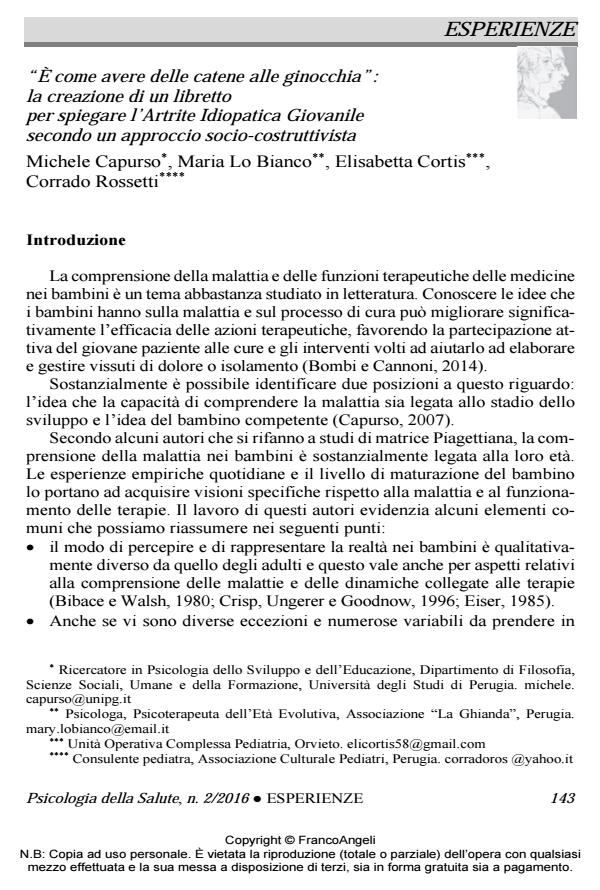"It’s like having chains on your knees". The creation of a booklet to explain Juvenile Arthritis using a socio-constructivist approach
Journal title PSICOLOGIA DELLA SALUTE
Author/s Michele Capurso, Maria Lo Bianco, Elisabetta Cortis, Corrado Rossetti
Publishing Year 2016 Issue 2016/2
Language Italian Pages 18 P. 143-160 File size 392 KB
DOI 10.3280/PDS2016-002008
DOI is like a bar code for intellectual property: to have more infomation
click here
Below, you can see the article first page
If you want to buy this article in PDF format, you can do it, following the instructions to buy download credits

FrancoAngeli is member of Publishers International Linking Association, Inc (PILA), a not-for-profit association which run the CrossRef service enabling links to and from online scholarly content.
The present article illustrates a social constructivist methodology employed in the creation of a children’s book whose aim is the explanation of Juvenile Idiopathic Arthritis (JIA)to newly diagnosed children. Such methodology is based on the active involvement of ill children and adolescent and is made of different phases: 1. the initial creation of a comic-based workbook; 2. the implementation of a workshop with children already affected by JIA; 3. the final collection and organisation of children’s narrative into a final children’s book; 4. the revision of the children’s materials with a group of expert and stakeholders. Each phase of the process led to a meaningful contribution of the final book. The employed social constructivist approach combined with an open and welcoming environment for children facilitated children’s expression of feelings and their ability to listen to their peers. Paediatric consultants gave scientific comments and made the final product medically solid and up-to-date with the latest therapeutic recommendations. This project shows how it is possible to provide writing recommendations and information to children with JIA. Children’s narratives provided insights and information that were sometimes new to medical practitioners and that would probably be otherwise neglected. The methodology explained here is based on a combination of narrative thought and social constructivism and has shown to be effective in helping children understand what JIA and may therefore be extended to future explanation of other children’s illnesses too.
Keywords: Children, understanding of illness, narrative thought, socio-constructivism, Juvenile arthritis, workshop.
Michele Capurso, Maria Lo Bianco, Elisabetta Cortis, Corrado Rossetti, "È come avere delle catene alle ginocchia": la creazione di un libretto per spiegare l’Artrite Idiopatica Giovanile secondo un approccio socio-costruttivista in "PSICOLOGIA DELLA SALUTE" 2/2016, pp 143-160, DOI: 10.3280/PDS2016-002008